
South America is a continent entirely in the Western Hemisphere and mostly in the Southern Hemisphere, with a relatively small portion in the Northern Hemisphere. It can also be described as the southern subregion of a single continent called America.

Vicia sativa, known as the common vetch, garden vetch, tare or simply vetch, is a nitrogen-fixing leguminous plant in the family Fabaceae. It is likely native to North Africa, Western Asia and Europe, but is now naturalized in temperate and subtropical regions worldwide. Although considered a weed when found growing in a cultivated grainfield, this hardy plant is often grown as a green manure, livestock fodder or rotation crop. More than 500,000 hectares per year of Vicia sativa is grown in Australia.

Forage is a plant material eaten by grazing livestock. Historically, the term forage has meant only plants eaten by the animals directly as pasture, crop residue, or immature cereal crops, but it is also used more loosely to include similar plants cut for fodder and carried to the animals, especially as hay or silage.
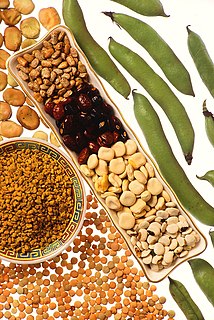
A legume is a plant in the family Fabaceae, or the fruit or seed of such a plant. When used as a dry grain, the seed is also called a pulse. Legumes are grown agriculturally, primarily for human consumption, for livestock forage and silage, and as soil-enhancing green manure. Well-known legumes include beans, soybeans, peas, chickpeas, peanuts, lentils, lupins, mesquite, carob, tamarind, alfalfa, and clover. Legumes produce a botanically unique type of fruit – a simple dry fruit that develops from a simple carpel and usually dehisces on two sides.

Nothoscordum is a genus of New World plants in the onion tribe within the Amaryllis family. It is probably paraphyletic. The genus is native to North and South America, though a few species have become naturalized in various parts of the Old World.
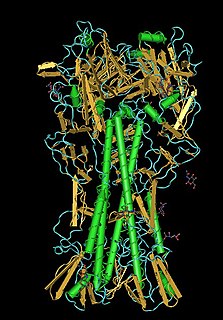
Lectins are carbohydrate-binding proteins that are highly specific for sugar groups that are part of other molecules, so cause agglutination of particular cells or precipitation of glycoconjugates and polysaccharides. Lectins have a role in recognition at the cellular and molecular level and play numerous roles in biological recognition phenomena involving cells, carbohydrates, and proteins. Lectins also mediate attachment and binding of bacteria, viruses, and fungi to their intended targets.
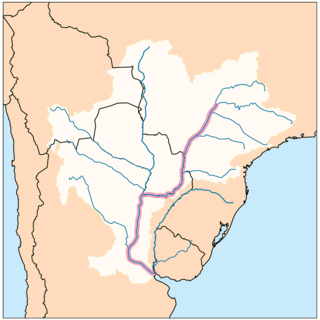
The Paraná River is a river in south Central South America, running through Brazil, Paraguay, and Argentina for some 4,880 kilometres (3,030 mi). It is second in length only to the Amazon River among South American rivers. It merges with the Paraguay River and then farther downstream with the Uruguay River to form the Río de la Plata and empties into the Atlantic Ocean.
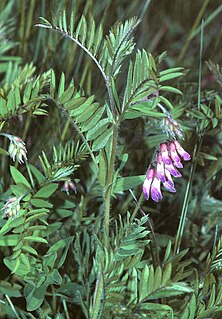
Vicia is a genus of over 240 species of flowering plants that are part of the legume family (Fabaceae), and which are commonly known as vetches. Member species are native to Europe, North America, South America, Asia and Africa. Some other genera of their subfamily Faboideae also have names containing "vetch", for example the vetchlings (Lathyrus) or the milk-vetches (Astragalus). The broad bean is sometimes separated in a monotypic genus Faba; although not often used today, it is of historical importance in plant taxonomy as the namesake of the order Fabales, the Fabaceae and the Faboideae. The tribe Vicieae in which the vetches are placed is named after the genus' current name. Among the closest living relatives of vetches are the lentils (Lens) and the true peas (Pisum).

Schinus is a genus of flowering trees and tall shrubs in the sumac family, Anacardiaceae. Members of the genus are commonly known as pepper trees. The Peruvian pepper tree is the source of the spice known as pink peppercorns. Some species have become an invasive species outside their natural habitats. Schinus polygama, although less well known, is also potentially weedy in mesic areas.

Ditaxis is a plant genus of the family Euphorbiaceae first described as a genus in 1824. Its name comes from Greek dis ("two") and taxis ("rank"), referring to the stamens which are in two whorls. The genus is widespread across much of the Western Hemisphere from the southern United States to Uruguay.
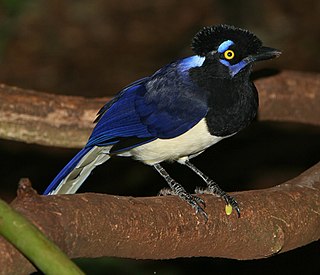
The plush-crested jay is a jay of the family Corvidae. It is found in central-southern South America: in southwestern Brazil, Bolivia, Paraguay, Uruguay, and northeastern Argentina, including southern regions of the Amazon Basin river systems bordering the Pantanal.
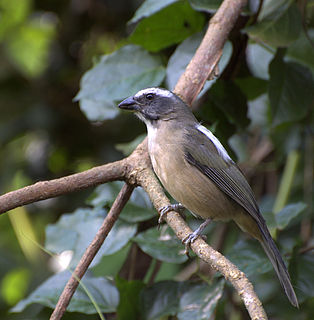
The green-winged saltator is a species of saltator in the family Thraupidae. It is found in Argentina, Bolivia, Brazil, Paraguay, and Uruguay, and ranges into the southern cerrado and the pantanal.
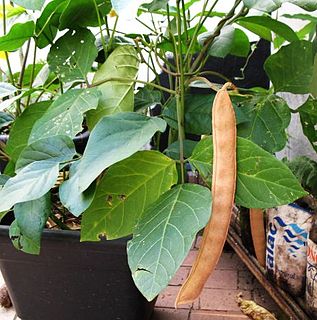
Canavalia ensiformis is a legume which is used for animal fodder and human nutrition, especially in Brazil where it is called feijão-de-porco. It is also the source of concanavalin A.
Oplismenopsis is a genus of South American plants in the grass family. The only known species is Oplismenopsis najada, native to southern Brazil, Uruguay, and northeastern Argentina.
Rhynchoryza is a genus of plants in the grass family. The only known species is Rhynchoryza subulata, native to Brazil, Argentina, Paraguay and Uruguay.
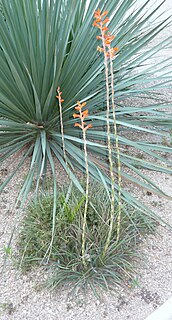
Dyckia remotiflora is a plant species in the genus Dyckia. It is native to Argentina, Uruguay, and Brazil.

Arjona is a genus of flowering plants in the family Schoepfiaceae. They are hemiparasites.

Myrrhinium is a genus of plants in the Myrtaceae first described as a genus in 1827. It contains only one recognized species, Myrrhinium atropurpureum, native to South America.
- Myrrhinium atropurpureum var. atropurpureum - SE Brazil
- Myrrhinium atropurpureum var. octandrumBenth. - (Colombia, Ecuador, Peru, S Brazil, Uruguay, N Argentina

Elwira Lisowska is a Polish biochemist and professor. She made significant contributions to the biochemistry of human blood groups, especially MNS and P1PK blood group systems, and to the immunochemical characterization of glycopeptide antigens.
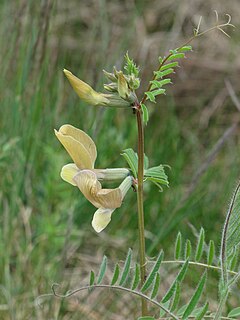
Vicia grandiflora, commonly known as large yellow vetch and bigflower vetch, as well as large-flowered vetch, is a common herbaceous plant species in the family Fabaceae, which occurs as a native plant species in Europe and Asia, as well as an introduced vetch species in North America.

















